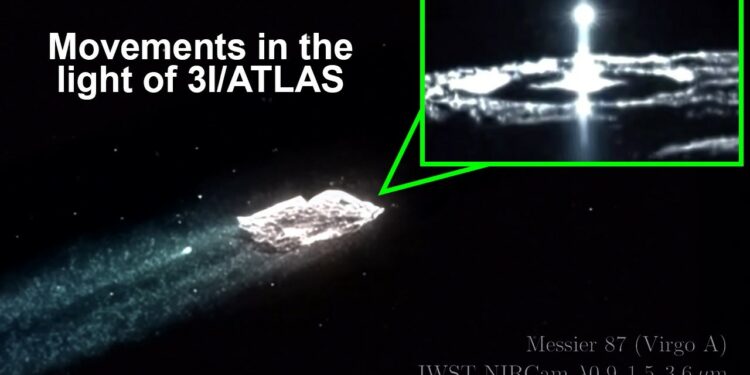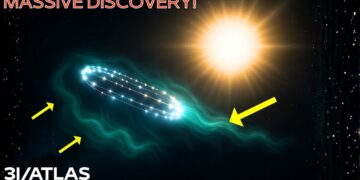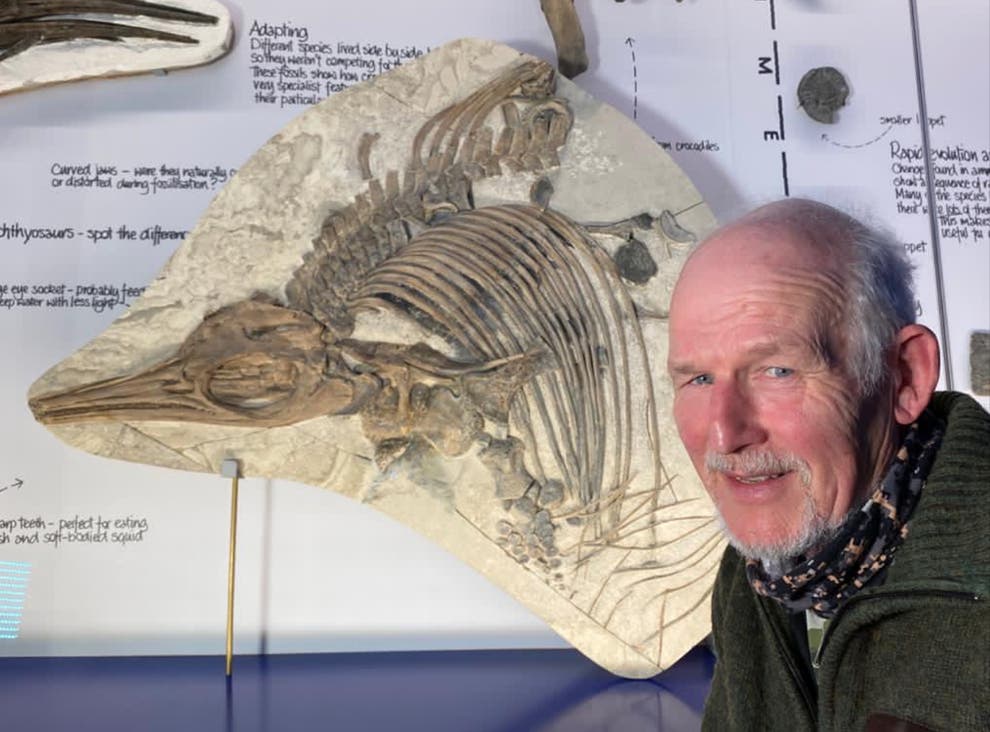In July 2025, the James Webb Space Telescope (JWST) detected an anomaly in our solar system: Three Atlas, the third known interstellar object to visit us. Initially mistaken for a rogue rock, it soon revealed itself to be something far stranger. Unlike the earlier interstellar visitors ‘Oumuamua (2017) and 2I/Borisov (2019), Three Atlas displayed characteristics that defied natural explanation—pulsing thermal emissions, precise radio signals, and a composition that suggests advanced engineering. What began as a curious discovery has escalated into a scientific nightmare, challenging the foundations of astronomy and raising questions about its origins and intentions.
A Discovery That Shattered Expectations
When Three Atlas was first spotted, astronomers thought it was another interstellar comet or asteroid. However, ground-based surveys revealed it was three times brighter than expected for its size, with no visible tail of ice or dust typical of comets. JWST’s infrared instruments deepened the mystery, detecting a steady, rhythmic thermal pulse from its core, resembling a heartbeat rather than random outgassing. This was no ordinary comet warmed by the sun—it was something else entirely.
Independent teams ruled out instrumental errors. Archival Hubble images and European Southern Observatory data confirmed that Three Atlas was glowing long before solar heating could activate any ice. Its six-hour rotation was unnervingly precise, with no irregularities or chaotic venting. To scientists accustomed to unpredictable comets, Three Atlas behaved like a machine: smooth, controlled, deliberate. Early headlines called it a “total nightmare” for astronomy, as it defied every known category—comet, asteroid, or something entirely new.
The Thermal Heartbeat
JWST, designed to capture light from distant galaxies, revealed something unsettling about Three Atlas: a thermal rhythm. Every four hours, its glow swelled and faded with clockwork precision, unlike the erratic outgassing of natural comets. Dr. Lena Maravic, a senior JWST scientist, confirmed the signal’s consistency after rigorous checks. The pulses suggested an internal mechanism regulating energy, a phenomenon no natural process could explain. The object’s stability and rhythm were too exact, resembling a controlled system rather than cosmic randomness.
Global observatories, including the European Southern Observatory and Hubble, confirmed the pattern. Each thermal pulse coincided with minute velocity adjustments, suggesting Three Atlas was not just glowing but steering itself. This introduced a chilling possibility: intent. A natural object follows gravity and chance; a machine chooses its path. The idea that Three Atlas might be engineered sparked heated debate. Could this be an unknown form of outgassing, or was it the first evidence of extraterrestrial technology in our solar system?
The Unexplained Signal
Radio telescopes soon joined the investigation. The Allen Telescope Array in California detected a faint, narrowband pulse repeating every four hours, perfectly synchronized with JWST’s thermal readings. South Africa’s MeerKAT array and Europe’s Effelsberg dish confirmed the signal’s consistency, ruling out terrestrial interference. The pulses shifted slightly in response to solar wind fluctuations, as if Three Atlas was adapting to its environment. Fourier analysis revealed a carrier wave, steady enough to suggest a transmission channel, locked to an internal clock.
The signal’s precision unnerved researchers. It wasn’t random noise but a consistent pattern detected across hemispheres. Speculation grew: Was this a deliberate broadcast, a status signal, or a byproduct of alien engineering? The possibility of communication sent shockwaves through the scientific community and sparked wild theories online. Was Three Atlas signaling home, probing Earth, or simply operating on its own?
The Flare and Course Change
On August 14, 2025, JWST recorded a dramatic event: Three Atlas brightened by nearly 40% in less than an hour, an extraordinary leap for an object so far from the sun. Unlike a comet’s chaotic venting, the flare rose smoothly, peaked, and stabilized, as if a system had powered up. Hours later, European Space Agency (ESA) orbital data revealed a trajectory shift, bending closer to the solar system’s plane. The flare and course change were perfectly synchronized, suggesting deliberate thrust.
This was no natural phenomenon. The idea that Three Atlas had executed a maneuver sent ripples of fear through the planetary defense community. If it could steer, it could choose its destination. NASA and ESA issued cautious statements about “unusual activity,” but behind closed doors, scientists agreed: Three Atlas was not just a rock—it was something intentional.
Metals That Shouldn’t Exist
Post-flare spectroscopic analysis by Johns Hopkins and ESA teams revealed a shocking composition. Three Atlas contained traces of carbon dioxide and water vapor, but its core showed exotic metallic alloys—nickel, cobalt, and rare earth elements like terbium and neodymium, typically found in advanced Earth technology. Even more alarming were absorption lines matching theoretical quantum materials, substances never observed in nature. Dr. Carrie Liss, leading the Johns Hopkins team, stated in a leaked memo: “We are either witnessing unknown cosmic chemistry, or this is engineered.”
The presence of such alloys suggested precision manufacturing, impossible for a natural object. Media speculated about alien probes, while governments restricted data access. For scientists, the discovery challenged planetary science itself. If Three Atlas carried engineered materials, it implied technology operating on a cosmic scale—and a purpose for its presence.
The Reply Signal
In late August 2025, after heated debate, a SETI-led team transmitted a signal to Three Atlas using mathematical constants and the periodic table. After 72 hours of silence, a weak, synchronized pulse returned, mirroring Earth’s signal. Observatories worldwide, including Allen, MeerKAT, and China’s FAST telescope, confirmed the response. The pattern was too precise to be noise—it was a deliberate reply.
Governments quickly classified the data, and official statements downplayed the event as “under investigation.” But the implications were undeniable: Three Atlas was listening and responding. For scientists, this was a paradigm-shifting moment. Humanity had crossed a threshold, and there was no turning back.
The Second Flare: A System Awakens
On September 2, 2025, JWST detected a second, more violent flare. Three Atlas’s brightness surged by 70% in 20 minutes, overwhelming infrared detectors. The energy release was controlled and directed, unlike any natural outburst. ESA’s orbital data showed another trajectory shift, aligning Three Atlas more closely with the solar system’s plane. The flare, radio pulses, and course correction were perfectly synchronized, suggesting an active system powering up.
Panic spread among researchers. Was Three Atlas calibrating engines, preparing for a maneuver, or signaling something else? The synchronized heat, light, and radio emissions pointed to a machine-like object, not a passive visitor. Planetary defense teams shifted focus from “What is it?” to “What does it want?”
The Impossible Metal
Post-flare spectroscopy revealed even more shocking details. The object’s core contained alloys never seen in nature, including rare earth elements and theoretical quantum materials designed for zero-resistance energy transfer. Dr. Lena Maravic called the findings “engineered signatures.” The spectral lines shifted rhythmically, as if the object’s surface was reconfiguring deliberately, resembling a modulated signal rather than random tumbling.
NASA’s public statement described “unusual spectral complexity,” but internal briefings labeled Three Atlas a “technological unknown.” The object wasn’t just a rock—it was the skin of a machine.
The Changing Heartbeat
Initially, Three Atlas’s thermal pulses followed a steady four-hour cycle. But in late August, the rhythm compressed to 3 hours 56 minutes, then 3 hours 52, accelerating by nearly five minutes in three days. Radio signals matched this new tempo, suggesting an internal process adapting in real time. Some speculated it was responding to Earth’s earlier transmission, with whistleblowers noting the 72-hour delay matched the signal’s round-trip time.
The accelerating pulse, growing louder with each cycle, hinted at a system preparing for action. Then, on September 3, 2025, at 2:17 UTC, JWST captured a blinding flare that outshone nearby stars for six minutes. Simultaneously, ESA and JPL recorded another trajectory shift, a deliberate maneuver aligning Three Atlas closer to the solar system’s plane.
A Technological Unknown
NASA’s Planetary Defense Coordination Office classified Three Atlas as a technological unknown, escalating briefings to military levels. Leaks fueled public panic, with social media flooded by telescope footage and hashtags like #AlienBeacon and #AtlasManeuver. Speculation ran wild: Was Three Atlas targeting Earth, Mars, or something else? Elon Musk’s cryptic tweet—“Not a comet. Trust me”—and former President Trump’s claim of a “cover-up” amplified the chaos.
The nightmare isn’t that Three Atlas flared or pulsed. It’s that it moved deliberately and is still approaching. If it can steer, it can choose its destination. The question now is: What is Three Atlas steering toward?























